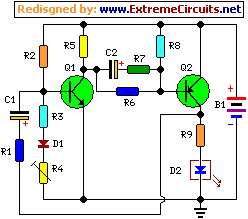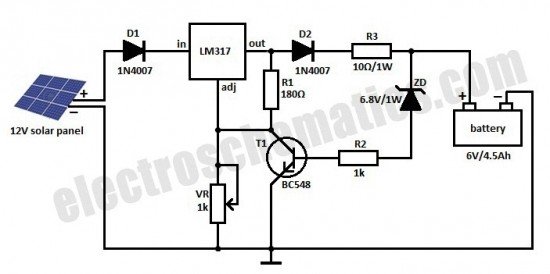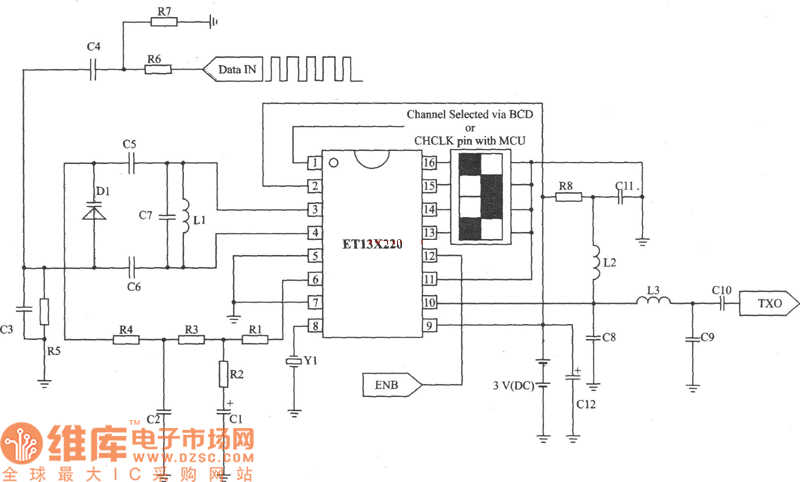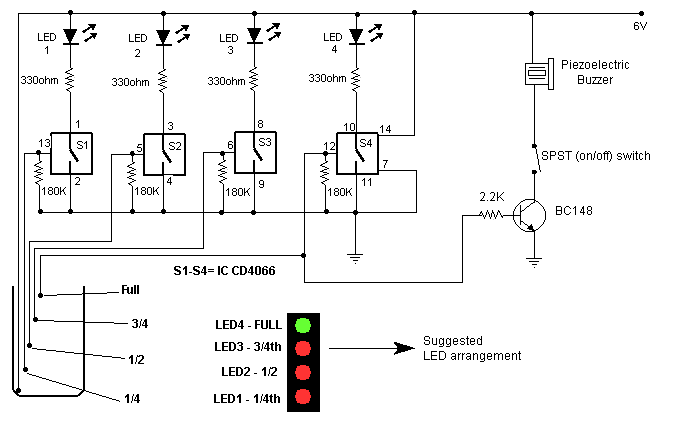
Flashing-LED Battery-Status Indicator Circuit

A battery-status indicator circuit is useful for monitoring portable test equipment and similar devices. LED D1 flashes to attract the user's attention, signaling that the circuit is operational, preventing it from being left on unintentionally. The circuit produces approximately two LED flashes per second, with an average current draw of about 200 µA. Transistors Q1 and Q2 are configured as an uncommon complementary astable multivibrator, remaining off 99% of the time and saturating only when the LED is illuminated, which helps maintain low current consumption. The circuit operates with battery supply voltages in the 5 to 12V range, and the LED flashing can be halted at the desired battery voltage (within the 4.8 to 9V range) by adjusting Trimmer R4. This range can be modified by slightly changing the values of R3 and/or R4. As the battery voltage approaches depletion, the LED flashing frequency will decrease significantly to alert the user. When the battery voltage drops below this threshold, the LED will remain permanently off. To stabilize the depletion voltage, diode D1 is included to compensate for changes in the Q1 base-emitter junction due to temperature variations. The use of a Schottky barrier diode (e.g., BAT46, 1N5819, etc.) for D1 is essential, as the circuit will not function correctly if a standard silicon diode like the 1N4148 is used.
The battery-status indicator circuit is designed to provide a clear and efficient method for monitoring battery levels in portable electronic devices. The astable multivibrator configuration utilizing Q1 and Q2 allows for a low-power operation, which is crucial for battery-powered applications. The flashing LED serves as an effective visual cue, ensuring that users are aware of the circuit's operational state.
The choice of using a Schottky diode for D1 is critical due to its low forward voltage drop, which minimizes the impact on the overall voltage level sensed by the circuit. This ensures accurate detection of the battery voltage and timely alerts to the user regarding battery status. The ability to adjust the threshold voltage with Trimmer R4 provides flexibility in tailoring the circuit to different battery types and capacities, enhancing its versatility across various applications.
In practical applications, the circuit can be integrated into devices such as handheld multimeters, portable oscilloscopes, or any battery-operated test instruments where monitoring battery life is essential. The design considerations, including the selection of component values for R3 and R4, should be made based on the specific requirements of the intended application to optimize performance and reliability.
Overall, this battery-status indicator circuit is a well-thought-out solution for ensuring users are informed about battery conditions, thereby preventing unexpected device shutdowns due to low battery levels.A Battery-status Indicator circuit can be useful, mainly to monitor portable Test-gear instruments and similar devices. LED D1 flashes to attire the user`s attention, signaling that the circuit is running, so it will not be left on by mistake.
The circuit generates about two LED flashes per second, but the mean current drawing will be about 200 µA . Transistors Q1 and Q2 are wired as an uncommon complementary astable multivibrator: both are off 99% of the time, saturating only when the LED illuminates, thus contributing to keep very low current consumption. The circuit will work with battery supply voltages in the 5 12V range and the LED flashing can be stopped at the desired battery voltage (comprised in the 4.
8 9V value) by adjusting Trimmer R4. This range can be modified by changing R3 and/or R4 value slightly. When the battery voltage approaches the exhausting value, the LED flashing frequency will fall suddenly to alert the user. Obviously, when the battery voltage has fallen below this value, the LED will remain permanently off.
To keep stable the exhausting voltage value, diode D1 was added to compensate Q1 Base-Emitter junction changes in temperature. The use of a Schottky-barrier device (e. g. BAT46, 1N5819 and the like) for D1 is mandatory: the circuit will not work if a common silicon diode like the 1N4148 is used in its place.
🔗 External reference
The battery-status indicator circuit is designed to provide a clear and efficient method for monitoring battery levels in portable electronic devices. The astable multivibrator configuration utilizing Q1 and Q2 allows for a low-power operation, which is crucial for battery-powered applications. The flashing LED serves as an effective visual cue, ensuring that users are aware of the circuit's operational state.
The choice of using a Schottky diode for D1 is critical due to its low forward voltage drop, which minimizes the impact on the overall voltage level sensed by the circuit. This ensures accurate detection of the battery voltage and timely alerts to the user regarding battery status. The ability to adjust the threshold voltage with Trimmer R4 provides flexibility in tailoring the circuit to different battery types and capacities, enhancing its versatility across various applications.
In practical applications, the circuit can be integrated into devices such as handheld multimeters, portable oscilloscopes, or any battery-operated test instruments where monitoring battery life is essential. The design considerations, including the selection of component values for R3 and R4, should be made based on the specific requirements of the intended application to optimize performance and reliability.
Overall, this battery-status indicator circuit is a well-thought-out solution for ensuring users are informed about battery conditions, thereby preventing unexpected device shutdowns due to low battery levels.A Battery-status Indicator circuit can be useful, mainly to monitor portable Test-gear instruments and similar devices. LED D1 flashes to attire the user`s attention, signaling that the circuit is running, so it will not be left on by mistake.
The circuit generates about two LED flashes per second, but the mean current drawing will be about 200 µA . Transistors Q1 and Q2 are wired as an uncommon complementary astable multivibrator: both are off 99% of the time, saturating only when the LED illuminates, thus contributing to keep very low current consumption. The circuit will work with battery supply voltages in the 5 12V range and the LED flashing can be stopped at the desired battery voltage (comprised in the 4.
8 9V value) by adjusting Trimmer R4. This range can be modified by changing R3 and/or R4 value slightly. When the battery voltage approaches the exhausting value, the LED flashing frequency will fall suddenly to alert the user. Obviously, when the battery voltage has fallen below this value, the LED will remain permanently off.
To keep stable the exhausting voltage value, diode D1 was added to compensate Q1 Base-Emitter junction changes in temperature. The use of a Schottky-barrier device (e. g. BAT46, 1N5819 and the like) for D1 is mandatory: the circuit will not work if a common silicon diode like the 1N4148 is used in its place.
🔗 External reference





